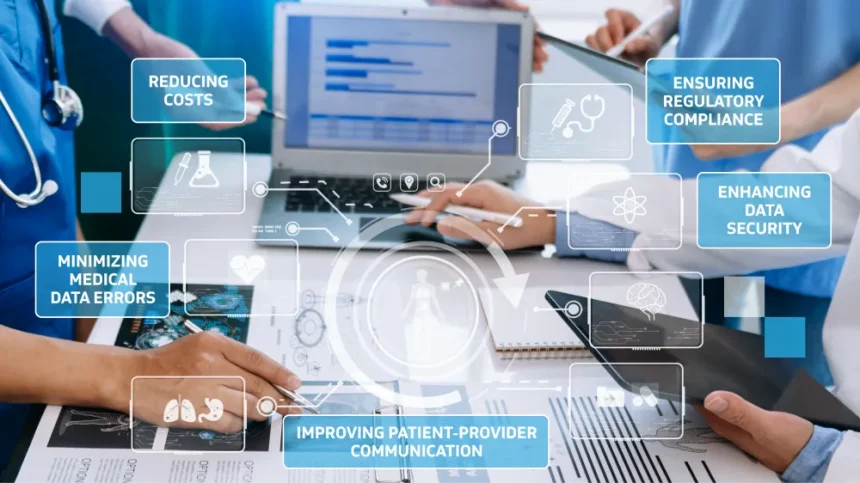Data compliance standards are key in ensuring interoperability, efficiency, and accuracy. They provide standardized codes and structured document formats for the smooth exchange of information between systems. Helping healthcare providers securely access data and provide efficient care to their patients.
We have listed the key compliance standards to help you understand their importance and usability so that you know all about the regulations that play a key role in healthcare software development.
This article begins with the first and the most prominent one, HIPAA, which was introduced in 1996.
Health Insurance Portability and Accountability Act (HIPAA)
HIPAA stands for Health Insurance Portability and Accountability Act, which was developed to protect healthcare information. It defines standards for storing, sharing, managing, and recording protected health information (PHI), which covers patients:
Name and Address
Dates and telephone numbers
Email address and social security number
Medical record number
Health plan beneficiary number
Account number and certificate/license number
Biometric identifiers
Any identification number
Web URLs and IP addresses
It requires the healthcare providers, insurers, and their business partners to ensure data protection through compliance rules built around privacy, breach notification, and security. Non-compliance can lead to heavy fines and legal repercussions.
Furthermore, HIPAA contains the security rules that describe the measures to protect PHI, such as technical, physical, and administrative safeguards.
Technical safeguards: It requires the encryption of Electronic PHI during
transfer. Healthcare institutions must follow the essential protocols such as access control, ePHI authentication, tracking of activity logs, audit controls, automatic logoff, encryption, and decryption.
Physical safeguards: Ensures the secure physical access to PHI and outlines measures to protect the mobile devices and workstations. The must-follow requirements for healthcare institutes are facility access controls, guidelines for using workstations, SOPs for using mobile devices, and inventory and hardware management policies.
Administrative safeguards: It refers to policies and procedures designed to manage the PHI security. It lays out the following requirements, like risk assessment and management policy, developing contingency plans, limiting third-party access to data, and reporting security incidents.
In addition to all this, the other rules in HIPAA that facilitate healthcare software development are:
The Privacy Rule: It explains how PHI should be disclosed and used, requiring healthcare organizations to train employees regarding the type of information that can be shared. In addition to implementing appropriate measures to maintain PHI security. Such as seeking patient permission before using their health information.
Breach Notification: This rule mandates that if PHI is compromised, the healthcare organization should quickly notify affected individuals and HHS (Health and Human Services), and alert the media (if over 500 individuals are impacted).
Omnibus Rule: It includes stakeholders like business associates and third-party services accountable for data protection.
The next one is the HL7, an international standard that allows the secure transfer of data in a standardized format between labs, providers, pharmacies, and much more.
Health Level 7 (HL7)
It is a set of healthcare data exchange standards that outlines the best practices for secure data transfer between systems. HL7 is crucial for seamless data exchange between systems. The two subsequent versions are v2 and v3:
HL7 v2: It is widely used to exchange real-time clinical and administrative data between hospital systems.
HL7 v3: It is a structured and standardized approach for healthcare data exchange using an XML-based format for enhanced interoperability.
HL7 also handles clinical documentation via HL7 Clinical Document Architecture (CDA). This is an XML-based standard that defines the structure and semantics of clinical documents (discharge summaries and procedure reports, etc)
Hospitals use electronic health records (EHRs) to exchange data, and HL7 standards play a key role in developing interoperable and compliant healthcare software. Partnering with an EHR software development company that ensures data exchange and regulatory compliance is now mandatory for healthcare institutions.
Fast Healthcare Interoperability Resources (FHIR)
It is an HL7-compliant standard that defines the approved data formats and APIs for electronic health records. FHIR aims to strengthen healthcare software compliance practices, particularly:
It allows healthcare providers to share data in JSON and XML formats via HTTP-based RESTful APIs.
FHIR is flexible because it uses modern web technologies and modular resources. Allowing easy integration and customization across multiple healthcare systems.
Health Information Technology for Economic and Clinical Health (HITECH)
HITECH is the Health Information Technology for Economic and Clinical Health Act. It encourages healthcare providers to adopt electronic health records, improves the security protections of healthcare data, and focuses on stricter enforcement. Some of its top features are given below:
In the event of unauthorized access, providers must notify the patients and run an audit to check compliance with HIPAA.
It requires the sharing of PHI via secure methods.
EHR systems are essential for the secure exchange of health data, but compliance is key, so always choose a healthcare solution development company that understands regulations like HIPAA and HITECH to ensure the solution is efficient and fully compliant.
General Data Protection Regulation (GDPR)
The General Data Protection Regulation, popularly known as GDPR, holds a narrow area for healthcare software compliance. But controls all data exchange in the European Union (EU). It also influenced the creation of the California Consumer Privacy Act (CCPA).
The compliance with GDPR can be ensured with the help of the following steps:
Appointment of a data protection officer to assess the data flows.
Assessing data-related risks by conducting a data protection impact assessment (DPIA).
Development and implementation of data protection strategy.
Informing the affected within 72 hours in case of a data breach.
International Classification of Diseases (ICD)
The ICD, which stands for International Classification of Diseases, is a system physicians utilize to code or classify all diagnoses, procedures, and symptoms. It was designed by the World Health Organization (WHO), and its latest version is ICD-11. Some of its top features are given below:
Developed for digital use with EHS.
Supports better data comparability across countries.
Enables easy integration with health IT tools and EHRs.
Allows monitoring of new and emerging health conditions.
Provides multilingual support to ensure widespread implementation.
Captures added clinical details via extension codes included.
When it is about protecting healthcare data, it is not just about having an EHR system. Instead, it’s about the implementation of compliance standards. The regulations like HIPAA, HL7, and HITECH can play a key role in ensuring the security of data. That’s why working with an EHR development company that implements these standards robustly in the EHR development is essential.
This also helps build trust, supports smooth data exchange, and minimizes legal risks. Some other regulations, too, promote the secure data exchange between systems. Some of the prominent ones are given below:
CMS Regulations (Centers for Medicare and Medicaid Services) include billing, patient safety, and quality reporting rules.
FDA Regulations apply when developing or using medical devices and software as medical devices (SaMD).
The Joint Commission standards focus on improving safety and quality in patient care.
All in all, the healthcare regulations protect the patient’s sensitive information and facilitate the smooth data exchange between systems. This helps the healthcare professionals provide efficient care.
Wrapping Up
Meeting compliance standards in healthcare is not fancy; it’s necessary because regulations like HIPAA, HITECH, and HL7 are not only there to protect patient data. But to ensure interoperability and save institutions from costly breaches and penalties. So, if you are thinking of developing a healthcare solution, make sure that your chosen company follows the required healthcare standards. Also, as a healthcare provider, you must stay updated on these standards to avoid fines or legal fallout.







